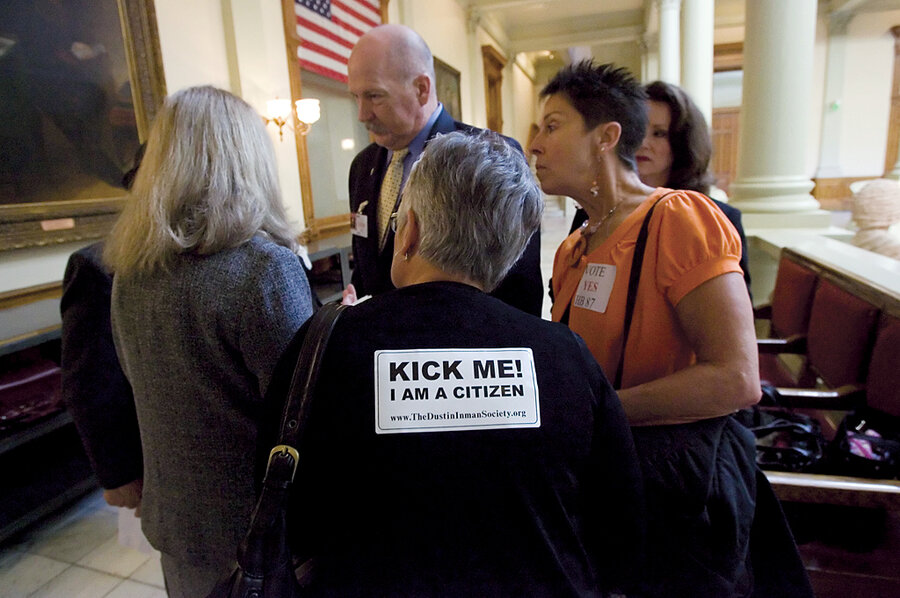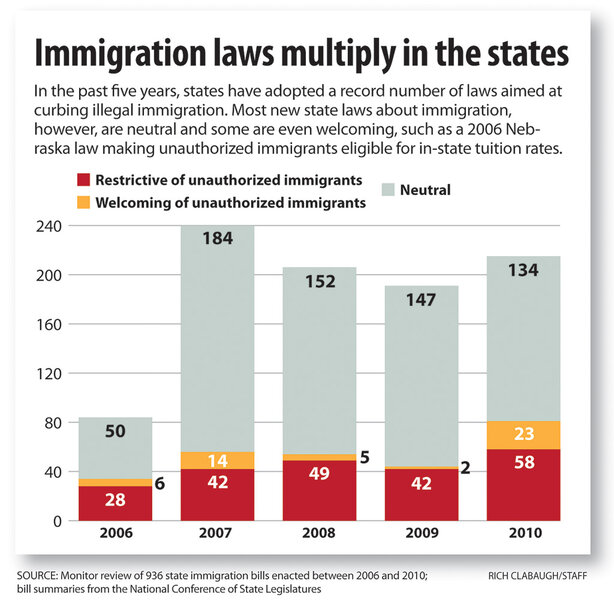State illegal immigration laws: What have they accomplished?
| Boston
The wave of immigration laws that has swept through states since 2006 shows few signs of letting up, with state legislators expected to introduce about 1,400 bills this year. Yet five years into this legislative surge, the toughest laws have not recast immigration in the ways that legislators might have intended.
From an enforcement standpoint, the impact of state anti-immigration laws like Arizona's controversial SB 1070 "is almost negligible," says Veronica Dahlberg, an immigrants' rights activist.
The far greater impact has been social, Hispanic groups say. Laws targeting illegal immigrants have reflected and even intensified the rising anti-immigration movement, both in statehouses and on the streets. The result is a legislative record from Arizona to Florida that hasn't made much of a mark on illegal immigration, but has fueled a populist backlash against it.
This is "particularly true in some places, because there's been very rapid growth in immigrant populations," says Marc Rosenblum, a senior analyst at the Migration Policy Institute.
The trend was sparked by a dramatic uptick in illegal immigration in the decade before 2006. Roughly half of all unauthorized immigrants now in the country – some 6 million in all – came to the United States during that period.
The response from state legislatures built rapidly. In 2006, they passed twice as many immigration laws as they had a year earlier. By 2008, they passed five times the 2005 number – a level that has stayed steady since. Last year, state legislators introduced about 1,400 immigration-related bills, more than 200 of which became laws.
The majority of these laws have been neutral on illegal immigration. But some of the most noteworthy have taken a tough stance, and more of the same is expected this year:
•About a dozen states are now considering bills like Arizona's SB 1070, which requires police officers to check a person's immigration status during routine stops.
•On March 16, Utah Gov. Gary Herbert (R) signed four immigration bills, which would, among other things, allow undocumented immigrants to work in the state and allow police to check the immigration status of people arrested for serious crimes. The bills were seen as an attempt to find a middle ground in the immigration debate.
•The Virginia legislature is considering an effort to ban unauthorized immigrants from enrolling in public universities.
•A Florida bill would require anyone employed in the state be run though E-Verify, a federal citizenship and immigration registry. Currently, all federal employees and contractors must be run through E-Verify, but applying this to all workers in a state would be a first.
Yet the track record for recent immigration legislation suggests that explicitly anti-illegal immigration bills are more the exception than the rule. Some 71 percent of the state immigration laws passed from 2006 to 2010 were neutral toward undocumented immigrants. A small portion of these laws could actually be said to be tolerant of unauthorized immigrants, such as a 2006 Nebraska law granting in-state tuition to some unauthorized immigrants. (See graphic.)
In a testament to the difficulty of passing tough laws, Arizona defeated a bill that would have denied citizenship to children who do not have at least one US citizen or permanent legal resident as a parent.
Moreover, by some measures, the farthest-reaching laws have had little impact. Arizona's SB 1070 has reportedly yielded no arrests, and enforcement of the portion of the law requiring police officers to check a person's immigration status is being delayed by a court challenge.
Oklahoma's HB 1804 was hailed by supporters as the toughest state immigration law in the US in 2007. It barred unauthorized immigrants from receiving state benefits and made transporting them a crime. After a year, the law had yielded three arrests and one conviction, the Associated Press reported.
But this is not to say that state and local policies have not had significant effects. When Prince William County in Virginia passed an SB 1070-style law in 2008, those embroiled in the debate say it became a very different place.
"It wasn't just that a law was passed. All of a sudden people felt threats of violence," says film producer Chris Rigopulos after a screening of "9500 Liberty," a documentary on the law.
In Arizona, an estimated 100,000 Hispanics left the state in the months after SB 1070 was enacted, according to a BBVA Bancomer Research study.
But according to Alicia Sandoval, who left Arizona for Ohio, this mass exodus was not just because of SB 1070. Ms. Sandoval, who came to the US from Mexico 10 years ago, says the law only formalized what had been going on for years. "When we first came to Arizona, there was no fear," Sandoval says through an interpreter. "The police wouldn't treat you bad, even if you didn't have any papers."
But that has changed. She points to the aggressive policies of Maricopa County Sheriff Joe Arpaio, who helped deport 26,000 people from 2007 to 2010 – all before SB 1070.
Sandoval worked at a bakery in the heavily Hispanic Phoenix neighborhood and often saw lines of cars pulled over by police officers when she got off work at 1 a.m. She says police would find reasons, such as expired tags, to pull over people.
"We need some sort of education on how we can be integrated into the community, and not be separated from it," says Sandoval.






